Swedish vs Albanian Community Comparison
COMPARE
Swedish
Albanian
Social Comparison
Social Comparison
Swedes
Albanians
8,881
SOCIAL INDEX
86.3/ 100
SOCIAL RATING
41st/ 347
SOCIAL RANK
7,071
SOCIAL INDEX
68.2/ 100
SOCIAL RATING
131st/ 347
SOCIAL RANK
Albanian Integration in Swedish Communities
The statistical analysis conducted on geographies consisting of 191,158,360 people shows a moderate positive correlation between the proportion of Albanians within Swedish communities in the United States with a correlation coefficient (R) of 0.438. On average, for every 1% (one percent) increase in Swedes within a typical geography, there is an increase of 0.033% in Albanians. To illustrate, in a geography comprising of 100,000 individuals, a rise of 1,000 Swedes corresponds to an increase of 32.9 Albanians.
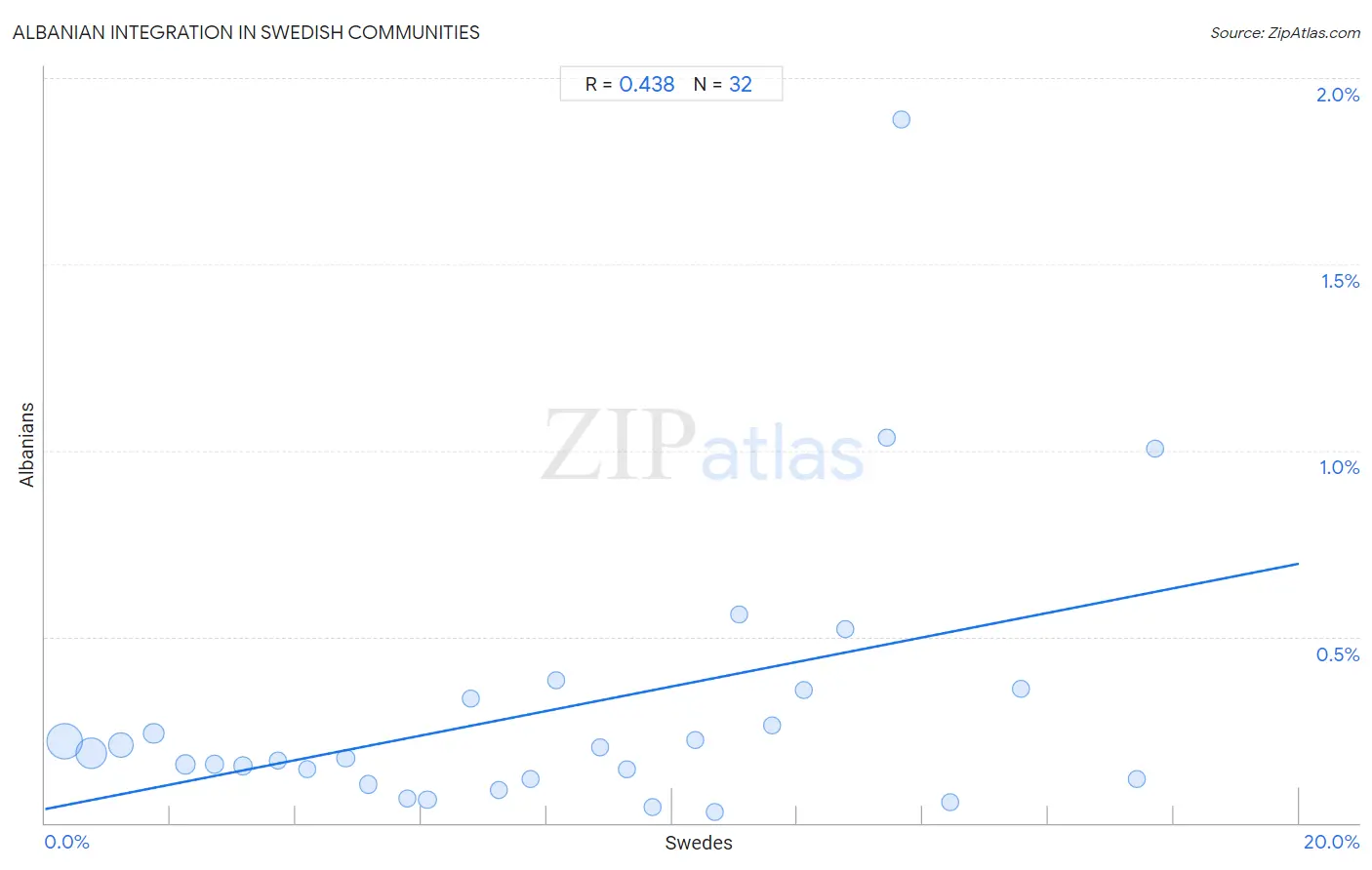
Swedish vs Albanian Income
When considering income, the most significant differences between Swedish and Albanian communities in the United States are seen in wage/income gap (29.4% compared to 25.4%, a difference of 15.7%), median female earnings ($39,421 compared to $42,584, a difference of 8.0%), and median earnings ($47,851 compared to $50,116, a difference of 4.7%). Conversely, both communities are more comparable in terms of householder income ages 45 - 64 years ($106,377 compared to $106,243, a difference of 0.13%), median family income ($108,499 compared to $109,136, a difference of 0.59%), and median household income ($88,524 compared to $89,744, a difference of 1.4%).

| Income Metric | Swedish | Albanian |
| Per Capita Income | Exceptional $45,750 | Exceptional $47,379 |
| Median Family Income | Exceptional $108,499 | Exceptional $109,136 |
| Median Household Income | Exceptional $88,524 | Exceptional $89,744 |
| Median Earnings | Excellent $47,851 | Exceptional $50,116 |
| Median Male Earnings | Exceptional $57,445 | Exceptional $58,680 |
| Median Female Earnings | Fair $39,421 | Exceptional $42,584 |
| Householder Age | Under 25 years | Excellent $52,986 | Exceptional $53,794 |
| Householder Age | 25 - 44 years | Exceptional $99,136 | Exceptional $101,367 |
| Householder Age | 45 - 64 years | Exceptional $106,377 | Exceptional $106,243 |
| Householder Age | Over 65 years | Excellent $62,736 | Fair $60,249 |
| Wage/Income Gap | Tragic 29.4% | Good 25.4% |
Swedish vs Albanian Poverty
When considering poverty, the most significant differences between Swedish and Albanian communities in the United States are seen in married-couple family poverty (3.9% compared to 5.0%, a difference of 30.6%), receiving food stamps (9.2% compared to 12.0%, a difference of 30.3%), and seniors poverty over the age of 65 (8.7% compared to 11.2%, a difference of 28.3%). Conversely, both communities are more comparable in terms of female poverty among 25-34 year olds (12.7% compared to 12.5%, a difference of 1.7%), single mother poverty (28.4% compared to 27.9%, a difference of 1.9%), and single male poverty (13.1% compared to 12.4%, a difference of 5.2%).
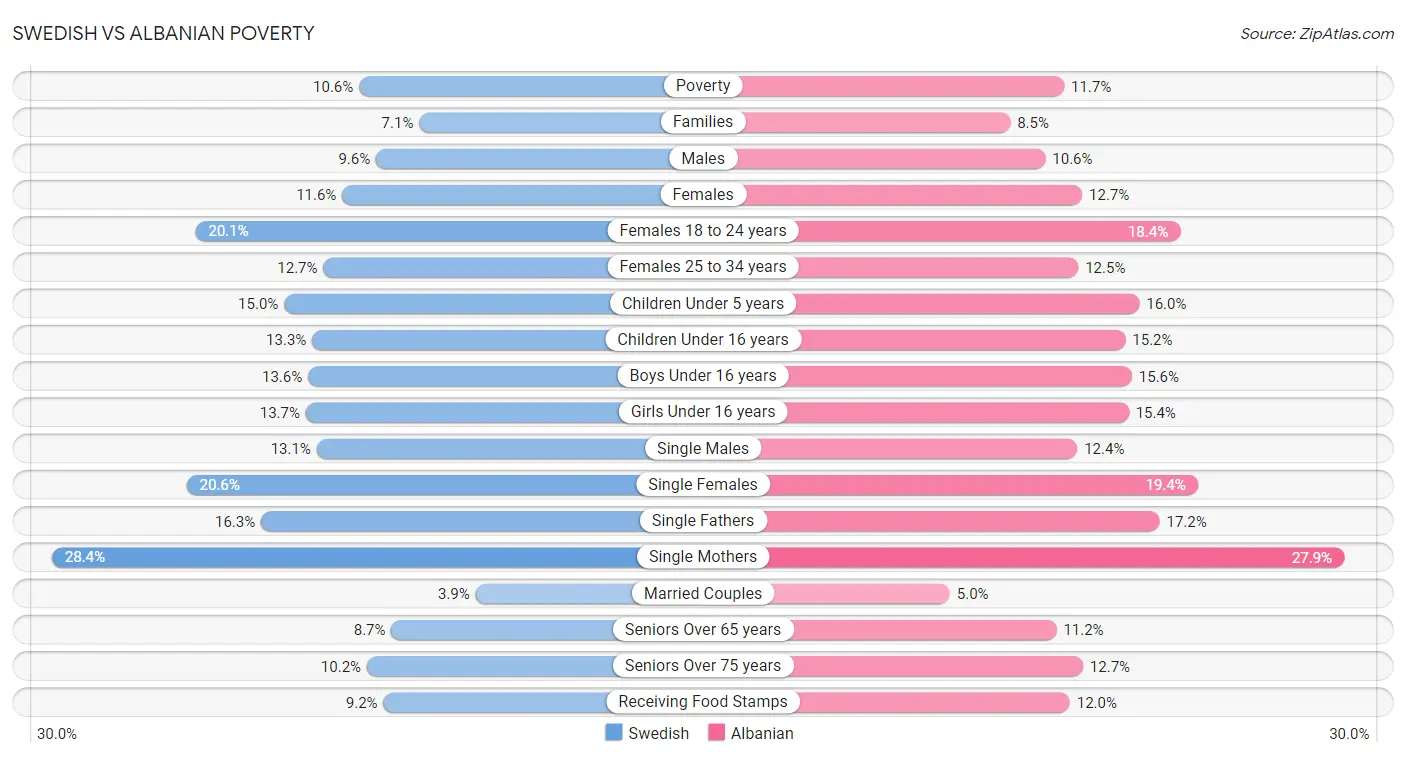
| Poverty Metric | Swedish | Albanian |
| Poverty | Exceptional 10.6% | Exceptional 11.7% |
| Families | Exceptional 7.1% | Excellent 8.5% |
| Males | Exceptional 9.6% | Exceptional 10.6% |
| Females | Exceptional 11.6% | Exceptional 12.7% |
| Females 18 to 24 years | Average 20.1% | Exceptional 18.4% |
| Females 25 to 34 years | Exceptional 12.7% | Exceptional 12.5% |
| Children Under 5 years | Exceptional 15.0% | Exceptional 16.0% |
| Children Under 16 years | Exceptional 13.3% | Excellent 15.2% |
| Boys Under 16 years | Exceptional 13.6% | Excellent 15.6% |
| Girls Under 16 years | Exceptional 13.7% | Exceptional 15.4% |
| Single Males | Poor 13.1% | Exceptional 12.4% |
| Single Females | Good 20.6% | Exceptional 19.4% |
| Single Fathers | Average 16.3% | Tragic 17.2% |
| Single Mothers | Excellent 28.4% | Exceptional 27.9% |
| Married Couples | Exceptional 3.9% | Good 5.0% |
| Seniors Over 65 years | Exceptional 8.7% | Fair 11.2% |
| Seniors Over 75 years | Exceptional 10.2% | Tragic 12.7% |
| Receiving Food Stamps | Exceptional 9.2% | Fair 12.0% |
Swedish vs Albanian Unemployment
When considering unemployment, the most significant differences between Swedish and Albanian communities in the United States are seen in unemployment (4.4% compared to 5.3%, a difference of 18.7%), unemployment among ages 16 to 19 years (15.3% compared to 18.2%, a difference of 18.5%), and male unemployment (4.6% compared to 5.4%, a difference of 17.0%). Conversely, both communities are more comparable in terms of unemployment among women with children ages 6 to 17 years (8.6% compared to 8.6%, a difference of 0.52%), unemployment among women with children under 6 years (7.4% compared to 7.2%, a difference of 3.3%), and unemployment among ages 60 to 64 years (4.5% compared to 4.7%, a difference of 4.6%).
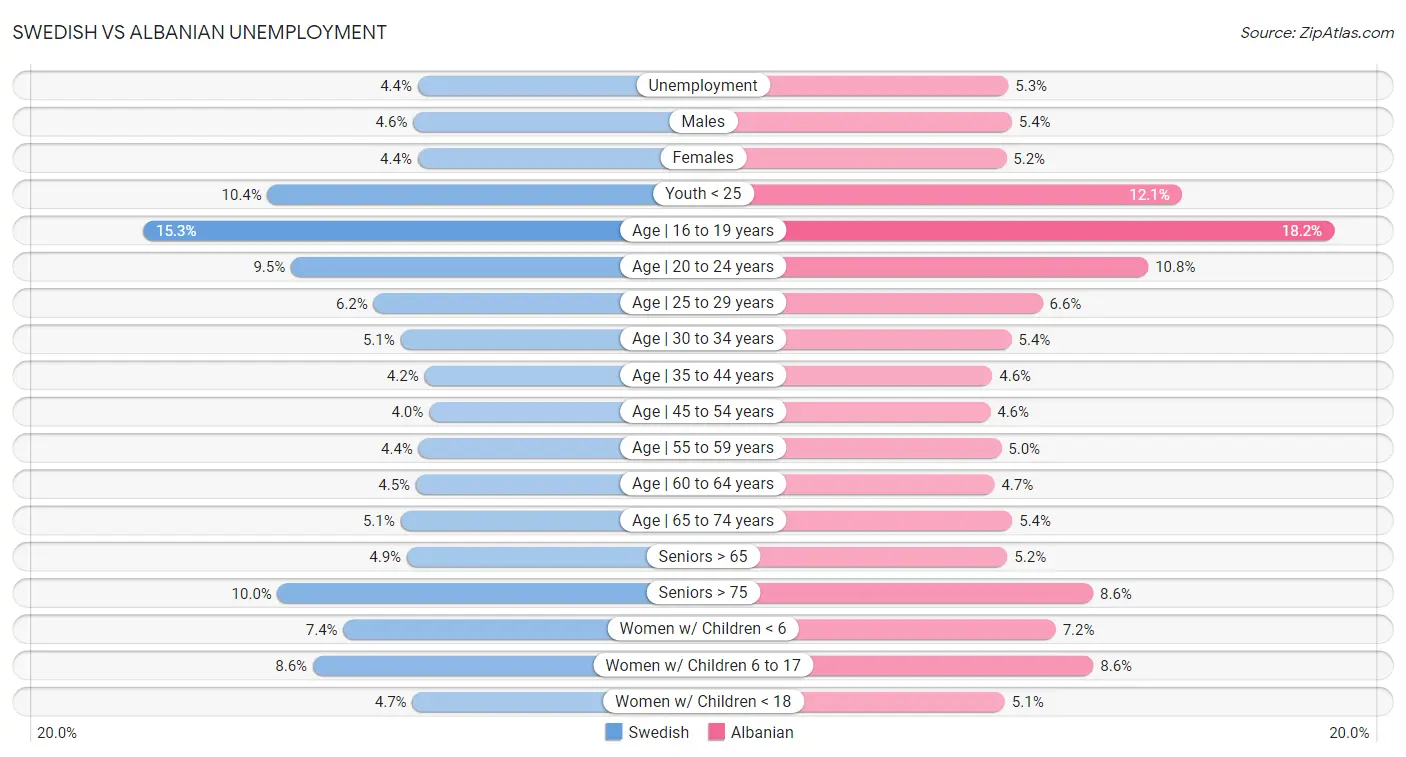
| Unemployment Metric | Swedish | Albanian |
| Unemployment | Exceptional 4.4% | Average 5.3% |
| Males | Exceptional 4.6% | Poor 5.4% |
| Females | Exceptional 4.4% | Good 5.2% |
| Youth < 25 | Exceptional 10.4% | Tragic 12.1% |
| Age | 16 to 19 years | Exceptional 15.3% | Tragic 18.2% |
| Age | 20 to 24 years | Exceptional 9.5% | Tragic 10.8% |
| Age | 25 to 29 years | Exceptional 6.2% | Average 6.6% |
| Age | 30 to 34 years | Exceptional 5.1% | Good 5.4% |
| Age | 35 to 44 years | Exceptional 4.2% | Good 4.6% |
| Age | 45 to 54 years | Exceptional 4.0% | Fair 4.6% |
| Age | 55 to 59 years | Exceptional 4.4% | Tragic 5.0% |
| Age | 60 to 64 years | Exceptional 4.5% | Exceptional 4.7% |
| Age | 65 to 74 years | Exceptional 5.1% | Poor 5.4% |
| Seniors > 65 | Exceptional 4.9% | Tragic 5.2% |
| Seniors > 75 | Tragic 10.0% | Good 8.6% |
| Women w/ Children < 6 | Excellent 7.4% | Exceptional 7.2% |
| Women w/ Children 6 to 17 | Exceptional 8.6% | Exceptional 8.6% |
| Women w/ Children < 18 | Exceptional 4.7% | Exceptional 5.1% |
Swedish vs Albanian Labor Participation
When considering labor participation, the most significant differences between Swedish and Albanian communities in the United States are seen in in labor force | age 16-19 (44.1% compared to 36.5%, a difference of 20.7%), in labor force | age 20-24 (78.8% compared to 74.6%, a difference of 5.7%), and in labor force | age 30-34 (85.2% compared to 85.7%, a difference of 0.62%). Conversely, both communities are more comparable in terms of in labor force | age 35-44 (85.0% compared to 85.1%, a difference of 0.040%), in labor force | age 20-64 (80.3% compared to 80.2%, a difference of 0.050%), and in labor force | age 25-29 (85.6% compared to 85.5%, a difference of 0.080%).

| Labor Participation Metric | Swedish | Albanian |
| In Labor Force | Age > 16 | Average 65.1% | Good 65.3% |
| In Labor Force | Age 20-64 | Exceptional 80.3% | Exceptional 80.2% |
| In Labor Force | Age 16-19 | Exceptional 44.1% | Average 36.5% |
| In Labor Force | Age 20-24 | Exceptional 78.8% | Poor 74.6% |
| In Labor Force | Age 25-29 | Exceptional 85.6% | Exceptional 85.5% |
| In Labor Force | Age 30-34 | Exceptional 85.2% | Exceptional 85.7% |
| In Labor Force | Age 35-44 | Exceptional 85.0% | Exceptional 85.1% |
| In Labor Force | Age 45-54 | Exceptional 83.7% | Exceptional 83.3% |
Swedish vs Albanian Family Structure
When considering family structure, the most significant differences between Swedish and Albanian communities in the United States are seen in single father households (2.3% compared to 2.0%, a difference of 16.9%), married-couple households (49.7% compared to 46.1%, a difference of 7.8%), and single mother households (5.5% compared to 5.9%, a difference of 7.6%). Conversely, both communities are more comparable in terms of family households (64.5% compared to 63.5%, a difference of 1.6%), average family size (3.10 compared to 3.17, a difference of 2.1%), and family households with children (27.4% compared to 26.5%, a difference of 3.4%).

| Family Structure Metric | Swedish | Albanian |
| Family Households | Good 64.5% | Tragic 63.5% |
| Family Households with Children | Fair 27.4% | Tragic 26.5% |
| Married-couple Households | Exceptional 49.7% | Fair 46.1% |
| Average Family Size | Tragic 3.10 | Tragic 3.17 |
| Single Father Households | Good 2.3% | Exceptional 2.0% |
| Single Mother Households | Exceptional 5.5% | Exceptional 5.9% |
| Currently Married | Exceptional 50.0% | Good 47.0% |
| Divorced or Separated | Fair 12.1% | Exceptional 11.5% |
| Births to Unmarried Women | Exceptional 29.6% | Exceptional 28.5% |
Swedish vs Albanian Vehicle Availability
When considering vehicle availability, the most significant differences between Swedish and Albanian communities in the United States are seen in no vehicles in household (6.8% compared to 15.6%, a difference of 130.3%), 4 or more vehicles in household (7.6% compared to 4.8%, a difference of 59.2%), and 3 or more vehicles in household (23.0% compared to 15.8%, a difference of 45.5%). Conversely, both communities are more comparable in terms of 1 or more vehicles in household (93.3% compared to 84.4%, a difference of 10.5%), 2 or more vehicles in household (61.8% compared to 49.0%, a difference of 26.2%), and 3 or more vehicles in household (23.0% compared to 15.8%, a difference of 45.5%).

| Vehicle Availability Metric | Swedish | Albanian |
| No Vehicles Available | Exceptional 6.8% | Tragic 15.6% |
| 1+ Vehicles Available | Exceptional 93.3% | Tragic 84.4% |
| 2+ Vehicles Available | Exceptional 61.8% | Tragic 49.0% |
| 3+ Vehicles Available | Exceptional 23.0% | Tragic 15.8% |
| 4+ Vehicles Available | Exceptional 7.6% | Tragic 4.8% |
Swedish vs Albanian Education Level
When considering education level, the most significant differences between Swedish and Albanian communities in the United States are seen in no schooling completed (1.4% compared to 2.1%, a difference of 46.2%), master's degree (15.2% compared to 17.0%, a difference of 11.5%), and professional degree (4.5% compared to 4.9%, a difference of 7.7%). Conversely, both communities are more comparable in terms of nursery school (98.7% compared to 98.0%, a difference of 0.71%), kindergarten (98.7% compared to 97.9%, a difference of 0.72%), and 1st grade (98.6% compared to 97.9%, a difference of 0.73%).
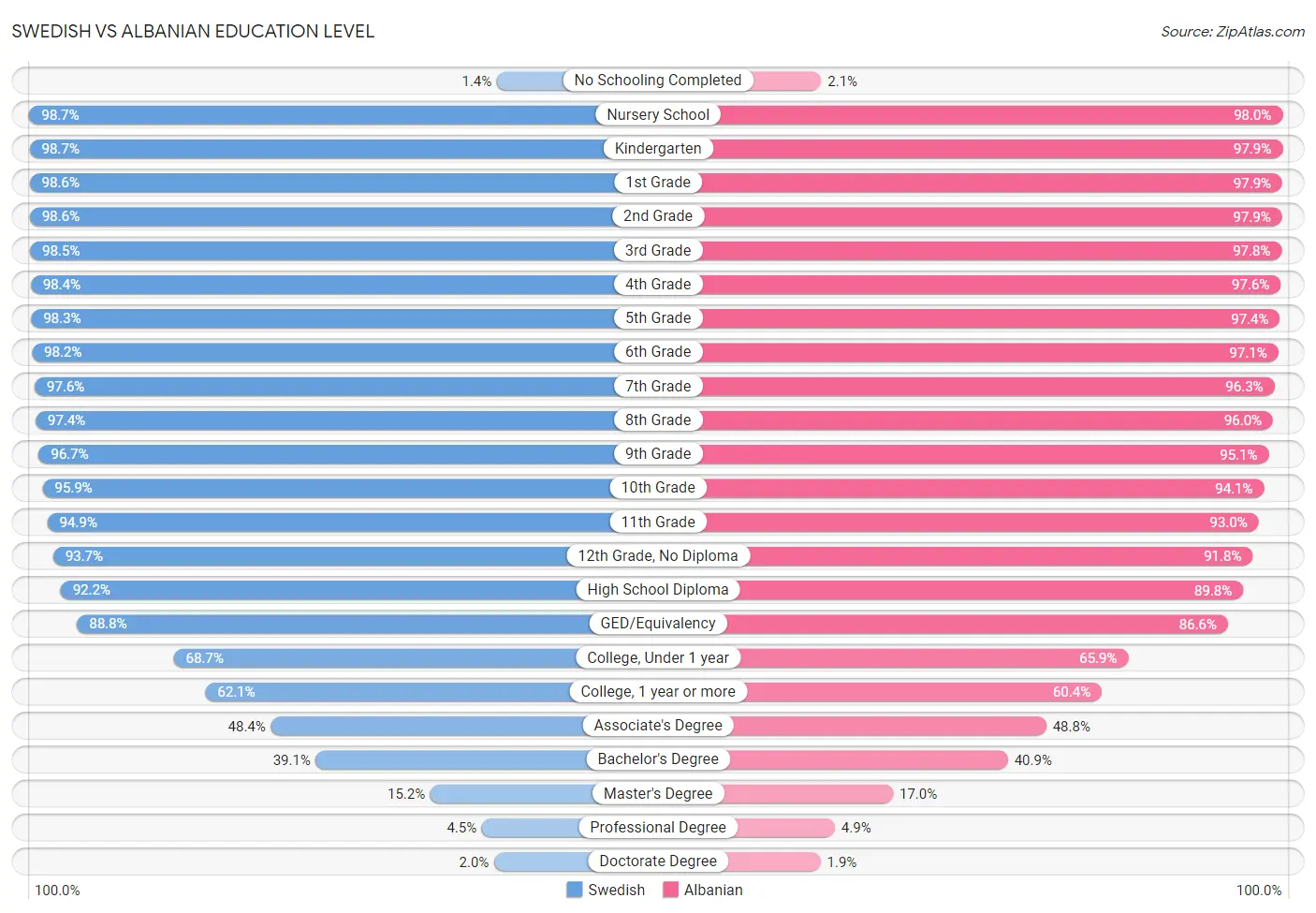
| Education Level Metric | Swedish | Albanian |
| No Schooling Completed | Exceptional 1.4% | Good 2.1% |
| Nursery School | Exceptional 98.7% | Average 98.0% |
| Kindergarten | Exceptional 98.7% | Average 97.9% |
| 1st Grade | Exceptional 98.6% | Average 97.9% |
| 2nd Grade | Exceptional 98.6% | Average 97.9% |
| 3rd Grade | Exceptional 98.5% | Average 97.8% |
| 4th Grade | Exceptional 98.4% | Good 97.6% |
| 5th Grade | Exceptional 98.3% | Good 97.4% |
| 6th Grade | Exceptional 98.2% | Average 97.1% |
| 7th Grade | Exceptional 97.6% | Excellent 96.3% |
| 8th Grade | Exceptional 97.4% | Excellent 96.0% |
| 9th Grade | Exceptional 96.7% | Good 95.1% |
| 10th Grade | Exceptional 95.9% | Excellent 94.1% |
| 11th Grade | Exceptional 94.9% | Excellent 93.0% |
| 12th Grade, No Diploma | Exceptional 93.7% | Excellent 91.8% |
| High School Diploma | Exceptional 92.2% | Excellent 89.8% |
| GED/Equivalency | Exceptional 88.8% | Excellent 86.6% |
| College, Under 1 year | Exceptional 68.7% | Good 65.9% |
| College, 1 year or more | Exceptional 62.1% | Good 60.4% |
| Associate's Degree | Exceptional 48.4% | Exceptional 48.8% |
| Bachelor's Degree | Good 39.1% | Exceptional 40.9% |
| Master's Degree | Good 15.2% | Exceptional 17.0% |
| Professional Degree | Good 4.5% | Exceptional 4.9% |
| Doctorate Degree | Excellent 2.0% | Good 1.9% |
Swedish vs Albanian Disability
When considering disability, the most significant differences between Swedish and Albanian communities in the United States are seen in disability age under 5 (1.6% compared to 1.1%, a difference of 38.4%), hearing disability (3.6% compared to 2.9%, a difference of 22.6%), and disability age 18 to 34 (7.5% compared to 6.4%, a difference of 17.9%). Conversely, both communities are more comparable in terms of vision disability (2.1% compared to 2.1%, a difference of 0.23%), disability age 65 to 74 (22.4% compared to 22.3%, a difference of 0.38%), and female disability (12.3% compared to 12.3%, a difference of 0.49%).
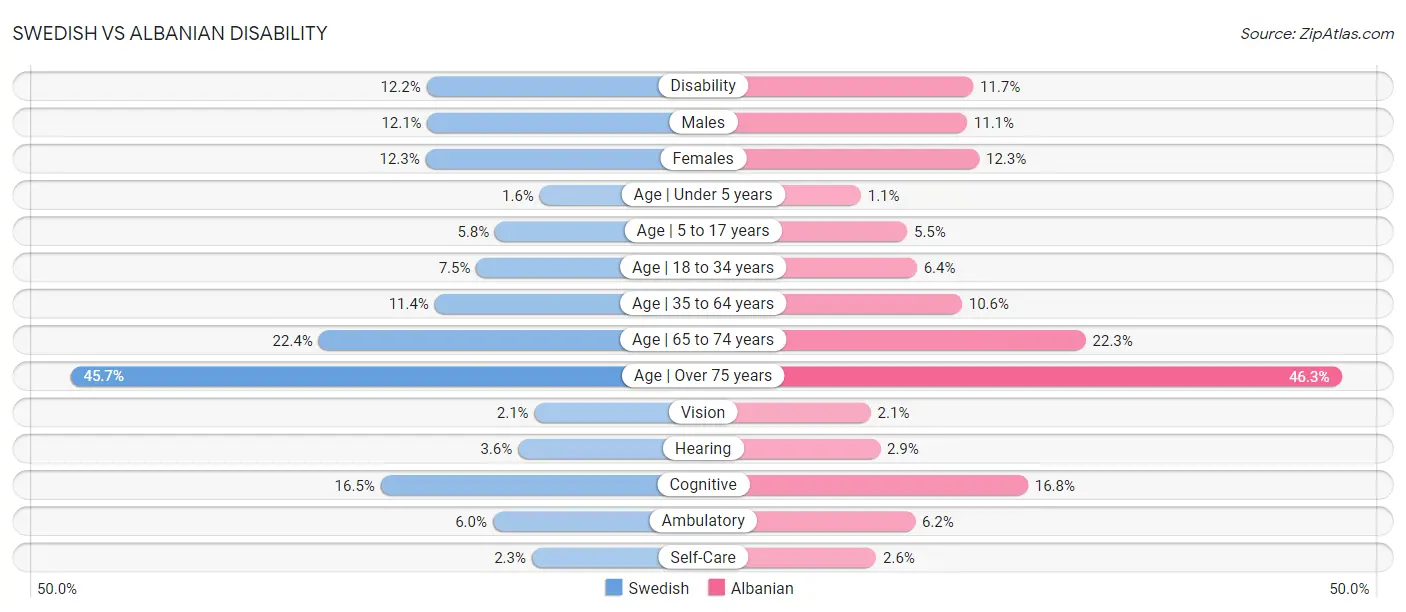
| Disability Metric | Swedish | Albanian |
| Disability | Tragic 12.2% | Average 11.7% |
| Males | Tragic 12.1% | Good 11.1% |
| Females | Fair 12.3% | Fair 12.3% |
| Age | Under 5 years | Tragic 1.6% | Exceptional 1.1% |
| Age | 5 to 17 years | Tragic 5.8% | Excellent 5.5% |
| Age | 18 to 34 years | Tragic 7.5% | Excellent 6.4% |
| Age | 35 to 64 years | Fair 11.4% | Exceptional 10.6% |
| Age | 65 to 74 years | Exceptional 22.4% | Exceptional 22.3% |
| Age | Over 75 years | Exceptional 45.7% | Exceptional 46.3% |
| Vision | Exceptional 2.1% | Exceptional 2.1% |
| Hearing | Tragic 3.6% | Good 2.9% |
| Cognitive | Exceptional 16.5% | Exceptional 16.8% |
| Ambulatory | Excellent 6.0% | Poor 6.2% |
| Self-Care | Exceptional 2.3% | Tragic 2.6% |